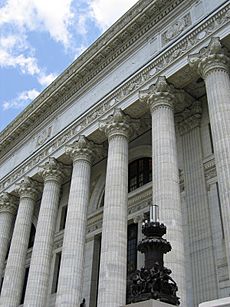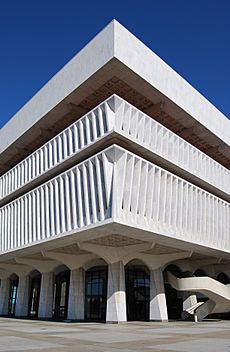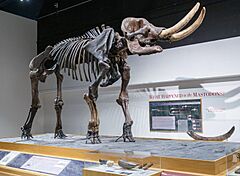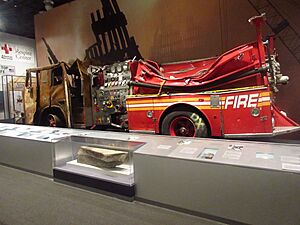New York State Museum facts for kids
 |
|

The Cultural Education Center hosts the New York State Museum
|
|
| Established | January 6, 1836 |
|---|---|
| Location | Empire State Plaza, Albany, New York, United States |
| Type | State museum of natural history, anthropology, and history |
The New York State Museum is a special place in Albany, New York, United States. It's a museum that uses research to learn about the past. You can find it on Madison Avenue, right next to the Empire State Plaza and facing the New York State Capitol.
This museum is home to amazing art and artifacts. These are objects from both ancient times and more recent history. It also has "ecofacts," which are natural items like plant remains. All these things help us understand New York's culture, nature, and how its land developed. The New York State Museum is run by the New York State Education Department. It is the oldest and largest state museum in the entire United States!
The museum used to be in the State Education Building. Now, it fills the first four floors of the Cultural Education Center. This huge building is also home to the New York State Archives and the New York State Library. In 2020, the museum, archives, and library had to close for a while because of the COVID-19 pandemic. But the museum staff kept working behind the scenes. They offered online programs and virtual exhibits. The museum welcomed visitors back on May 17, 2021, with new hours and some exhibits still getting ready.
Contents
Discovering the Museum's History

The New York State Museum started way back in 1836. It was first called the New York State Geological and Natural History Survey. Governor William Marcy created it to study the state's valuable minerals.
In 1870, it changed its name to the New York State Museum of Natural History. It was then overseen by the leaders of the State University. The museum was located in the State Education Building from 1912 until 1976. That's when it moved to its current home in the Cultural Education Center. This move happened after the Empire State Plaza was finished. The new location opened on July 4, 1976. About 15,000 people came to the opening ceremony, which even included a performance by Don Mclean.
In June 2015, the museum announced a big plan to update its exhibits. Over three to four years, a large area of exhibition space was modernized. The museum stayed open during this work. However, some galleries might have closed temporarily for construction.
Important People at the Museum
Many important people have worked at the museum over the years. Here are a few:
- Frederick James Hamilton Merrill – He was the museum director from 1894 to 1904.
- John Mason Clarke – He led the museum as director from 1904 to 1925.
- William Martin Beauchamp – He was an archaeologist who worked there from 1884 to 1910.
- James Hall – He was the State Paleontologist from 1841 to 1898. He also served as the State Geologist from 1891 to 1898.
Exploring the Museum's Layout
Most of the museum's permanent exhibits are on the first floor. This floor has very high ceilings. This allows for huge artifacts and displays. You can see a real subway car, old fire engines, and a recreated Mohawk Iroquois Longhouse. There's even a giant mastodon skeleton!
Smaller areas on the first floor hold temporary art shows. They also feature temporary exhibits about science, history, and different cultures. The Museum Theater hosts presentations and lectures. You can find it near the West Gallery. There's also a special center for student visitors behind the main lobby. The Museum Store is next to the main lobby. It sells souvenirs, cool mineral samples, and books about New York State.
The second floor is usually not open to the public. It's where education and youth services are located. The museum's staff, including researchers and exhibit designers, work on the third floor. This floor is also not open to visitors.
The fourth floor has a working carousel that was built between 1912 and 1916. Visitors can ride it for free! This floor also has exhibits about different regions and historic cities in New York State. These cities include Buffalo and Rochester. The walls on this floor are made of windows. They offer amazing views of the Empire State Plaza and downtown Albany. That's why this gallery is called "Windows on New York."
Museum Research and Programs
The New York State Museum is also a research center. It has several programs that help us learn more about New York State. These programs study geology, biology, archaeology, and history. Here are some of them:
- The Center for Stratigraphy and Paleontology (CSP) – This group studies the layers of rock and fossil history of New York. They also share geological data with the public. The CSP works to protect and make available the museum's large collections of fossils.
- Cultural Resource Survey Program (CRSP) – This program does historical and archaeological research for New York State. Their work helps other state agencies follow laws about preserving cultural and historic sites. This includes a federal law called the National Historic Preservation Act of 1966.
- The Laboratory for Conservation and Evolutionary Genetics (LCEG) – This lab helps researchers study how animals and plants have changed over time. They use technology to look at the DNA of different organisms. The lab also has a "Genome Bank." This is a collection of frozen tissues that saves plant and animal DNA for future studies.
- The Wildlife Science and Conservation Initiative – This program looks at how human activities affect animals. They study how things like building new areas change the behavior and lives of carnivores. They have mostly focused on carnivores in New York State.
Amazing Museum Collections
The New York State Museum has many different collections. These include geological samples, fossil specimens, historical items, and art. Their collections about people and cultures are very large. They include items from famous anthropologists like Lewis H. Morgan and Arthur C. Parker. Researchers can study these collections. The museum also has a storage facility in Rotterdam, New York. This is where they keep items not currently on display. This includes artifacts from the September 11 attacks.
Permanent Exhibits to Explore
- The Adirondack Wilderness – This exhibit explores the Adirondacks. You can learn about their geology and ancient plants and animals. It also shows how activities like logging and mining affected the environment. The exhibit covers current conservation efforts and artistic views of the area.
- The American Stoneware Collection – In 2014, a collection of 19th-century American stoneware was given to the museum. This exhibit includes old stoneware jugs, crocks, and jars.
- Ancient Life of New York – A Billion Years of Earth History – This exhibit features fossils that are over a billion years old. Some of these are among the oldest in the eastern United States. You can see ancient bacteria, fossilized tree stumps, and armored fish.
- Birds of New York – This display shows over 170 different bird species that live in New York. They are shown in their natural environments.
- Black Capital: Harlem in the 20s – This exhibit celebrates the art and culture of the Harlem Renaissance from the 1920s. It shows how this important movement developed and influenced later art and culture.
- Carousel – Located on the fourth floor, this full-sized carousel was built between 1912 and 1916. It was used in Cuba, New York, until the early 1970s. The museum then got it and put it back together. It works perfectly, and visitors can ride it for free!
- Cohoes Mastodon – These are the skeletal remains of a mastodon. It was found in Cohoes, New York, in 1866. The skeleton was repaired and restored in 1997. You can now see it in the South Hall of the museum. It has a new display and interactive tools to help you learn.
- Fire Engine Hall – This exhibit displays historic fire fighting vehicles from the 1800s and 1900s.
- The Governor's Collection of Contemporary Native American Crafts – This exhibit showcases modern crafts made by Native American artists.
- Metropolis Hall – This exhibit tells the story of New York City. It includes a real R9 New York City Subway car. You can also see recreated storefronts from Chinatown and Little Italy. There's even a reproduction of the famous brownstone stoop from the Sesame Street TV show.
- Minerals of New York – This display features geological samples from the museum's mineral collection.
- Native Peoples of New York – This exhibit explores the cultural history of Native groups in New York State. It covers a long period, from ancient times (around 10,000 BCE) to today. You can see ancient pottery and stone tools. There are also lifelike dioramas and a full-sized replica of an Iroquoian longhouse.
- Research Gallery – This gallery highlights the current work being done by the museum's research staff.
- Windows on New York – Located on the fourth floor, this exhibit shows the history and features of many different regions across New York State.
- The World Trade Center: Rescue, Recovery, Response – This exhibit tells the story of the World Trade Center and the events of September 11, 2001. It covers the rescue efforts and the recovery of evidence. It also shows how people responded to the attacks. The exhibit includes many artifacts from the site. These include parts of a fire engine and the flag that flew next to the North Tower.
See also





